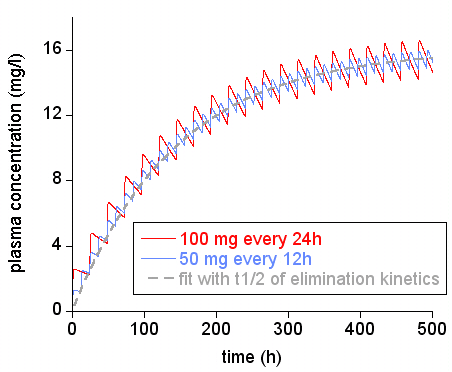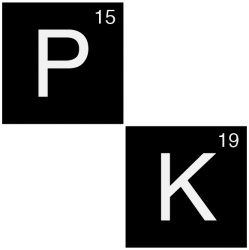“Drug administration of a fixed dose at a regular time interval, through a given route”
Description
The most common approach to the maintenance of drug therapy is the repeated administration regimen.
In repeated administration, accumulation occurs when the drug is administered before the previous dose is completely eliminated. The amount of drug in the body will then progressively rise. In the most common case of first-order kinetics, the rate of drug elimination will increase proportionally. When the rate of drug elimination compensates the rate of drug administration, the average drug concentration reaches steady state or plateau. At steady state, the amount of drug lost in each interval equals the amount gained, that is the dose multiplied by the bioavailability. Therefore, the plasma concentration fluctuates between doses similarly from one dosing interval to another.
The factors affecting the average steady state concentration are:
- Rate of dose administration (unit dose divided by dosing interval), which affects proportionally the steady state plasma concentration.
- Bioavailability, which modulates rate of dose administration.
- Clearance: Reduced clearance will lead to higher steady state concentration, and vice-versa, making clearance inversely related to steady state concentration.
During the dosing interval, the factors affecting the fluctuation of plasma concentration around the average concentration are:
- Frequency of drug administration: For a similar dosing rate, the greater the relative frequency of administration, the smaller the plasma fluctuation.
- Elimination half-life: The longer the half-life, the smaller the plasma fluctuation
- Rate of absorption: slower rate of absorption leads to a decrease in plasma fluctuation.
The time required to reach steady state is determined by the drug’s half-life, as is the time it takes to reach a new plateau after a change in regimen.
Clinical implications
As a result of accumulation, plasma concentrations reach higher levels during repeated regimen than after administration of a single dose. This is especially important for drugs with long half-lives.
The repeated administration regimen is used to ensure an exposure to the drug within the therapeutic range over a prolonged time. Drugs with a narrow therapeutic window need a more accurate selection of dosage regimen, which must be adapted to the patient’s clearance and bioavailability.
Chart Pharmacokinetics
Related terms
τ : dosing interval, h.
Loading dose: In some situations, the steady state plasma concentration must be reached more rapidly. A higher dose can then be administered on treatment initiation, to compensate for accumulation.
Accumulation index (RAC): Index reflecting the extent of drug accumulation and determined by the ratio of plasma concentration at plateau over plasma concentration after the first dose. It depends only on the dosing interval with regard to the half-life of the drug.
Assessment
The average steady state concentration can be assessed using the equation:
$$C_{ssav}=F*Dose \over CL*\tau$$
τ = dosing interval, h
F = Bioavailability
CL = Clearance
The accumulation index (RAC) can be calculated by the following equation:
$$RAC= {1 \over 1 - e^{- \lambda * \tau}}$$
λ = elimination constant rate = CL/Vd
Using the accumulation index the steady state concentration can be estimated by the equation:
$$C_{ssav} \approx RAC*C_{\text{single dose}}$$
Rate of accumulation to plateau:
The amount of drug in the body rises on multiple dosing just as it does following a constant-rate IV infusion (see intravenous infusion). That is, the approach to the plateau depends solely on the drug’s elimination half-life. The simulation for the antiepileptic drug phenobarbital in the the figure below illustrates this point. This drug has a half-life of 4 days (? 100 h) and is given at a dose of 100 mg once daily. The figure plots the plasma concentration of phenobarbital as a function of time for the application scheme 100 mg per day, and for comparison for 50 mg twice per day. The figure shows that the approach to the plateau is the same for the two application schemes, and the average plasma concentration follows an exponential time course with the half-life corresponding to that of drug elimination. Therefore, after three elimination half-lives 88%, and after four half-lives 94 % of the steady state concentration is reached.

Simulation of Phenobarbital plasma concentration during repeated oral administration for the application schemes indicated. Based on Vd = 38 L, CL = 0.26 L/h (t1/2 = 100 h), F = 1.

